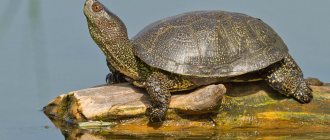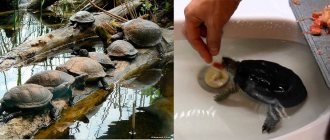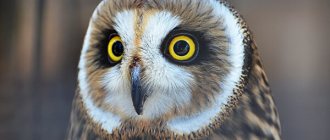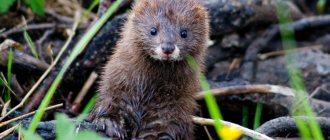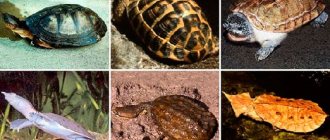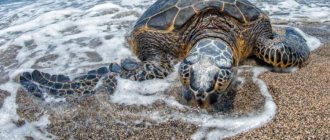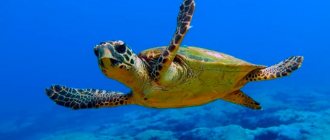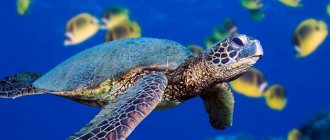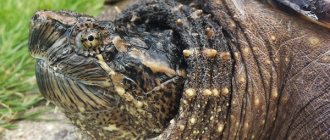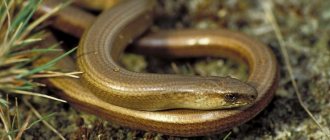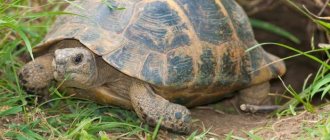In total, there are about 328 species of turtles in nature. They are divided into sea and land. Sea turtles live in seas and oceans and come to land only to lay eggs. Among terrestrial turtles there are freshwater and land ones. Land animals live on land. Freshwater animals live in bodies of water and periodically crawl onto land.
The European marsh turtle is a freshwater species of turtle. The number of marsh turtles is significantly declining, which is why this species is listed in the Red Book.
Description (appearance)
The carapace (the dorsal shield of the shell) is not just a kind of “house” for the turtle, it is part of its skeleton. It consists of a bone base and a horny covering. The carapace of the marsh turtle is oval-shaped, convex, the surface is smooth. The length of the shell reaches 35 cm. The color of the shell is from dark olive to dark brown with small yellow dots or streaks.
The plastron (the ventral shield of the shell) can be concave, convex or flat, depending on the sex of the turtle. The color of the plastron is mainly yellowish, but it can also be dark brown.
The turtle's body (head, neck, limbs, tail) is dark in color with yellow spots. The tail of the marsh turtle is quite long, it can reach 12 cm, which is 3/4 of the length of the shell. Adults can weigh up to 1.5 kg.
The head is large, there is no beak. The iris of the eyes can be yellow, orange or red, depending on gender. The paws are very large with sharp claws and membranes.
Features of hibernation
Under natural conditions, with the onset of cold weather, these freshwater animals spend the winter, namely, hibernate. In winter, sleep is a necessary condition for these animals. The fact is that they are cold-blooded species; for this reason, in cold times they cannot monitor the level of their body temperature.
They can also hibernate at home, but their sleep usually does not last long. This is due to the fact that the necessary microclimate conditions are always observed in the aquarium. Some opponents of turtle hibernation explain this by saying that the preparatory process for wintering takes too much time and effort.
Kinds
There are 7 main subspecies:
- Emys orbicularis occidentalis - western marsh turtle;
- Emys orbicularis persica - Persian marsh turtle;
- Emys orbicularis galloitalica - Gallo-Italian marsh turtle;
- Emys orbicularis eiselti - Eiselt's marsh turtle;
- Emys orbicularis hellenica - Eastern Mediterranean marsh turtle, Hellenic marsh turtle;
- Emys orbicularis ingauna.
- Emys orbicularis orbicularis is the nominate subspecies.
There are other subspecies of marsh turtles:
- Emys orbicularis luteofusca - golden-black marsh turtle;
- Emys orbicularis colchica - Colchian marsh turtle;
- Emys orbicularis kurae - Kura marsh turtle;
- Emys orbicularis capolongoi - Capolongo marsh turtle;
- Emys orbicularis lanzai - Lanza marsh turtle;
- Emys orbicularis iberica - Iberian marsh turtle;
- Emys orbicularis fritzjuergenobstii - Obst's marsh turtle;
- Emys orbicularis hispanica - Spanish marsh turtle;
- Emys orbicularis orientalis is an eastern marsh turtle.
Subspecies of the marsh turtle differ in size, appearance, as well as location and region of habitat.
Literature
- Ananyeva N. B., Orlov N. L., Khalikov R. G., Darevsky I. S., Ryabov S. A., Barabanov A. V.
Atlas of reptiles of Northern Eurasia (taxonomic diversity, geographic distribution and conservation status). - St. Petersburg: Zoological Institute of the Russian Academy of Sciences, 2004. - P. 21. - 1000 copies. — ISBN 5-98092-007-2. - Bannikov A. G., Darevsky I. S., Ishchenko V. G., Rustamov A. K., Shcherbak N. N.
Key to amphibians and reptiles of the fauna of the USSR. Textbook manual for students of biology. specialties ped. institutions. - M.: Education, 1977 - P. 73-74. - Gurzhiy A. N.
Aquarium and land turtles. - M.: Delta-M, 1999. P. 74-78. - Zavyalov E.V., Tabachishin V.G., Shlyakhtin G.V.
Modern distribution of reptiles in the north of the Lower Volga region. modern herpetology. 2003. Volume 2. pp. 52-67. - Kurylenko B.G., Verves Yu.G.
Amphibians and lycopes of the fauna of Ukraine: Dovidnik-Viznachnik (Navch. pp.) - K.: Geneza, 1998. - P. 115-119. - Makhlin M. D.
Turtles at your home. - M.: Delta-M, 2000. - P. 35-39. - Orlova V.F., Semenov D.V.
Nature of Russia. Life of animals. Amphibians and reptiles. - M.: "LLC Firm "AST Publishing House", 1999. - P. 131-134. - Pupins M.F., Pupinya A.
Experiences and problems of zooculture of the endangered species in Latvia
Emys orbicularis
L. / Zooculture and biological resources. Materials of the scientific and practical conference. Moscow: T-vo scientific publications KMK. 2005. - Ruchin, A. B., Ryzhov M. K.
Red Book of the Republic of Mordovia: amphibians and reptiles // Natural heritage of Russia: study, monitoring, protection. Mat. intl. scientific conf. Tolyatti 2004. p. 232—233 - Ryzhov M.K.
Finds of a marsh turtle in the Republic of Mordovia // Current problems of herpetology and toxicology. Sat. scientific works Vol. 9. Tolyatti 2006. pp. 159-164. - Life of animals in 7 volumes / Ch. editor V. E. Sokolov.
T. 5. Amphibians and reptiles.
/ A. G. Bannikov, I. S. Darevsky, M. N. Denisova
, etc.;
edited by A. G. Bannikova
- 2nd ed., revised. - M.: Education, 1985. - P. 134-136. - Dinçer Ayaz, Uwe Fritz, Mehmet Kutsay Atatur, Ahmet Mermer, Kerim Cicek, and Murat Aafsar
.
Aspect of Population Structure of the European Pond Turtle ( Emys orbicularis
) in Lake Yayla, Western Anatolia, Turkey. Journal of Herpetology, Vol. 42, No. 3, pp. 518—522, 2008 - G. F. Ficetola, E. Padoa-Schioppa, A. Monti, R. Massa, F. De Bernardi and L. Bottoni
.
The importance of aquatic and terrestrial habitat for the European pond turtle ( Emys orbicularis
): implications for conservation planning and management. Can. J Zool. 82: 1704–1712 (2004). - MAL Zufi, A. Celani, E. Foschi & S. Tripepi
.
Reproductive strategies and body shape in the European pond turtle ( Emys orbicularis
) from contrasting habitats in Italy. Journal of Zoology 271 (2007) 218–224 - M. L. Zuffi, F. Odetti and P. Meozzi
.
Body size and clutch size in the European pond turtle ( Emys orbicularis
) from central Italy. J. Zool., Lond. (1999) 247, 139–143 - P. Lenk, U. Fritz, U. Joger and M. Wink
.
Mitochondrial phylogeography of the European pond turtle, Emys orbicularis
(Linnaeus 1758). Molecular Ecology (1999) 8, 1911–1922 - Slawomir Mitrus
.
Spatial distribution of nests of the European pond turtle, Emys orbicularis
(Reptilia: Testudines: Emydidae), from long-term studies in central Poland. Zoologische Abhandlungen (Dresden) 55, 2006: 95—102 - Uwe Fritz, Tiziano Fattizzo, Daniela Guicking, Sandro Tripepi, Maria Grazia Pennisi, Peter Lenk, Ulrich Joger & Michael Wink
. A new cryptic species of pond turtle from southern Italy, the hottest spot in the range of the genus Emys (Reptilia, Testudines, Emydidae). Zoologica Scripta, Volume 34, Number 4, July 2005, pp. 351—371
Habitat where he lives
The marsh turtle is common in Russia, Ukraine, the Caucasus, Europe, Central Asia, and northwest Africa. It has a fairly wide habitat.
Lives in forest, steppe or forest-steppe areas. Lives in various fresh water bodies: swamps, ponds, lakes, slow-flowing rivers, canals. The water must be warm.
They prefer to settle close to the shore so that they can periodically crawl onto land to bask in the sun.
Tula region
Exotarium (Tula) Species: Chinese trionix, Seychelles tortoise, matamata, vulture, marsh, spurred, radiant tortoise. Address: Oktyabrskaya st., 26 Telephone Website: https://www.tulazoo.ru/
Lifestyle
European marsh turtles are very active and mobile reptiles. During the day they hunt, swim and bask on rocks or on land in the sun. These reptiles are excellent swimmers and divers. If there is danger or a threat to life, a marsh turtle can jump from a steep cliff directly into the water. Some species are able to dive from a height of 2-3 meters.
When in danger, a marsh turtle can hide at the bottom for quite a long time, or burrow into the mud. But she cannot stay under water all the time. The maximum time a turtle can stay underwater is 2 hours. Usually every 10-15 minutes the reptile comes to the surface to take in air.
In the water, marsh turtles are very nimble. The long tail acts as a “rudder” and helps it change direction sharply. On land they are not as agile as in water, but much faster than land turtles.
Some species can move up to 1 km from the reservoir. They are also capable of climbing mountains to heights of up to 2 thousand meters.
The enemies of reptiles are predatory animals and birds. Foxes, wolves, raccoons, otters, ferrets, eagles and crows destroy turtle nests. They not only destroy eggs, but can also feast on small defenseless turtles.
Swamp Turtle in the Red Book
The species has long been included in the Red Data Books of Lithuania, Latvia, Armenia and Belarus. The rare turtle was taken under protection in many European countries. The marsh turtle is found in nature reserves. In some regions, the population is rapidly declining or has disappeared completely.
Important! A high percentage of marsh turtles persist in the lower reaches of large rivers in the Black Sea, Mediterranean and Caspian Sea. In these areas, human activity contributes to an increase in the population of the species.
Main causes of extinction
The European marsh turtle has become very rare in Western Europe. The main danger to reptiles is from poachers who catch them. The meat and eggs of reptiles are consumed by humans; various products are made from their shells.
Another cause of extinction is environmental pollution. Poor ecology reduces the life expectancy of reptiles and negatively affects the reproduction of the species.
Birds of prey and animals also contribute to the destruction of the population. White-tailed eagles, foxes and raccoon dogs destroy turtle nests and prey on the young.
Current population situation
The European bog turtle is protected. It cannot be caught, sold or destroyed. In Russia, the species lives quite well and reproduces in the southern regions. In the north, the number is rapidly declining. In Europe the situation is more dire. A rare reptile species has completely disappeared from many parts of its range.
What measures are taken to protect
The reptile species, which is on the verge of extinction, is prohibited from being caught, kept at home, sold or destroyed. Freshwater bodies in many habitats are carefully protected.
Swamp turtles are bred in reserves that were created specifically to preserve rare species of animals and plants. For endangered reptiles, there are nurseries where they are cared for, fed and bred.
Reproduction
Puberty in a marsh turtle occurs at 6-8 years. The mating season for reptiles begins in the spring and lasts from May to July. Turtles can mate both in water and on land.
After mating, after 1-2 months, the reptile is ready to lay eggs. The turtle lays its eggs on the shore of a pond. She digs a hole 10 cm deep and then lays 5 to 10 eggs there. The weight of one egg is about 8 grams.
Depending on the air temperature, the incubation period lasts 2 or 3 months. The babies dig holes not far from the laying site and go into hibernation. Wintering begins in October, when the air temperature drops significantly. In the spring, when the air warms up to 6-15 degrees, the babies come out of hibernation and begin an independent life.
Kaluga region
Bird Park "Sparrows" (Kaluga region)
Species: pig-necked turtle, red-eared turtle, spurback turtle, Amboin turtle
Address: Kaluga region, Zhukovsky district, Village of State Farm "Pobeda" Tel.: 8 (48439) 934 26 Website: www.birdspark.ru
Sadovy (Moscow region)
Species (23): Indochinese Box, Indian Lobate, Cross-breasted, Snake-necked, Decorated Box, Cayman, Common Musk, Bighead, Matamata, Vulture, Two-clawed, Radiant, Charcoal, Spurneck, Leopard, Splendid Forest, Vietnamese Keeled, Carolina, Spiny, Red-bellied short-necked, red-eared, swamp, Chinese trionix
Address: Moscow region, Dolgoprudny st. Vinogradnaya 9R (5 km from the Moscow Ring Road along Dmitrovskoe Highway) Website: https://redniva.ru/
